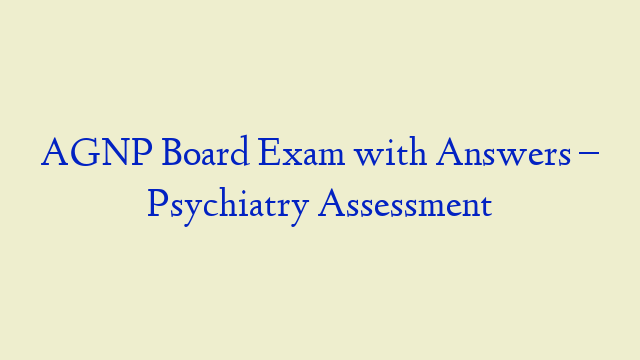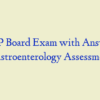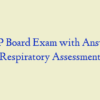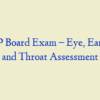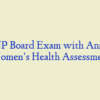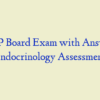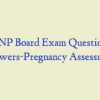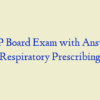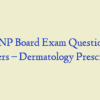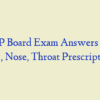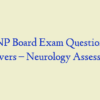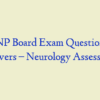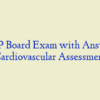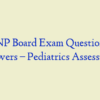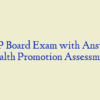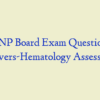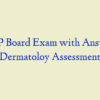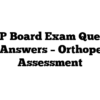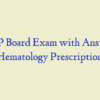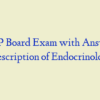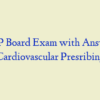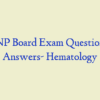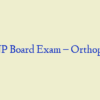Description
AGNP BOARD EXAM QUESTIONS Psychiatry Assessment (40 Questions)
- A 48-year-old woman states that she began smoking about 10 cigarettes per day at 20 years of age. How should this subjective history be documented?
- An example of an alcohol assessment screening tool is the:
- A seven- year -old is suspected of having conduct disorder. Which one of the following topics should the nurse practitioner include in the assessment history?
- The personality disorder characterized by patterns of attention-seeking, often dramatic behavior to gain the approval of others is:
- What is the leading cause of serious injury among U.S. women of reproductive age?
- Which of the following statements made by a parent would alert the nurse practitioner to suspect autism spectrum disorder?
- Which mental health disorder is characterized by reoccurring thoughts, feelings, images, and sensations that lead to repetitive behaviors?
- Physical manifestations of anxiety disorder would include all of the following except:
- Social phobia, panic disorder, and post-traumatic stress disorder (PTSD) are all examples of:
- A multifactorial geriatric condition or syndrome characterized by an age-related lack of adaptive physiological capacity occurring in the absence of identifiable illness is known as:
- A 65-year-old man presents with complaints of daytime sleepiness, unrestful sleep, and loud snoring. These symptoms are MOST consistent with:
- The Clinical Institute Withdrawal Assessment for Alcohol Withdrawal (CIWA) recommends inpatient management for scores higher than:
- Anticipatory guidance for the family of a pre-adolescent with a cognitive impairment should include information about:
- Extreme anxiety about physical symptoms (i.e., pain or fatigue) that causes intense thoughts and behaviors that interfere with daily life is classified as:
- Which of the following is NOT a symptom associated with the formal diagnosis of attention-deficit hyperactivity disorder (ADHD) in a child?
- What is the second leading cause of death among U.S. women of reproductive age?
- An intermediate stage between the expected cognitive decline of normal aging and the more serious decline of dementia is known as:
- Which one of the following questions is NOT asked in the CAGE questionnaire?
- Assessment findings of Russell’s sign is NOT indicative of:
- A soldier states that since returning from active duty 2 months ago, he is experiencing sleep disturbance, irritability, low energy, and difficulty with concentration. These findings are consistent with:
- Symptoms of Sundown syndrome may include:
- Which one of the following is at the HIGHEST risk for suicide?
- What geriatric condition is characterized by reduction in physical or mental capacity sufficient to interfere with managing day to day tasks?
- Which one of the following findings is not typical in a patient who has delirium?
- Mood disorders include all of the following except:
- A serious disturbance in a person’s mental abilities that results in a decreased awareness of one’s environment and confused thinking is referred to as:
- Which mental health disorder is characterized by an overwhelming feeling of sadness, isolation, and despair that lasts 2 weeks or longer?
- A 25-year-old with the mental age of a toddler, who exhibits limited language skills and can be trained in very basic activities of daily living, such as dressing, hygiene and feeding, would be classified as:
- When asked about alcohol use, the 55-year-old man states that he has no more than 4 drinks a day or 14 drinks a week. This information suggests:
- Which one of the following statements is true of Munchausen Syndrome by Proxy?
- A mental health condition characterized by over-the-top behavior such as emotional outbursts, noisy displays of temper, compulsive attention seeking and self-centered actions is:
- Which diagnosis describes people often found to be criminals, who habitually violate the rights of others without remorse?
- Which behavior is NOT an observation of a patient’s affect?
- The personality disorder characterized by symptoms of instability with self-image, affect, and marked impulsivity is:
- During which part of the routine office visit should a person be asked questions related to physical and sexual abuse?
- Which of the following is NOT a Diagnostic and Statistical Manual of Mental Disorders (DSM-5) criteria for diagnosing attention deficit disorder (ADD)?
- During the mental status exam, a 45-year-old woman is easily distractible and seems to have difficulty responding to each question. This is an assessment of:
- A flat affect can be an identifiable finding in an older adult who has:
- A patient presents with persistent thoughts of contamination, and dressing and undressing rituals. These symptoms are consistent with:
- Which of the following symptoms would be consistent with Attention Deficit Hyperactivity Disorder (ADHD)?
